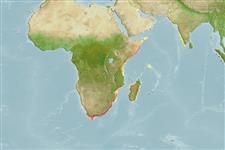>
Eupercaria/misc (Various families in series Eupercaria) >
Sparidae (Porgies)
Etymology: Pachymetopon: Greek, pachys = fat + Greek, metopon = brow (Ref. 45335).
More on author: Günther.
Environment: milieu / climate zone / depth range / distribution range
Ecología
marino demersal. Subtropical
Western Indian Ocean: southern Mozambique and Madagascar to Cape of Good Hope in South Africa.
Length at first maturity / Tamaño / Peso / Age
Maturity: Lm 30.0 range ? - ? cm
Max length : 65.0 cm TL macho / no sexado; (Ref. 3198); common length : 35.0 cm TL macho / no sexado; (Ref. 3507)
Espinas dorsales (total): 11; Radios blandos dorsales (total): 11; Espinas anales 3; Radios blandos anales: 10 - 11. Old specimens develop a marked blue budge between the eyes.
Found near rocks in coastal waters. Feeds on ascideans, crustaceans, and algae. Good food fish but not sufficiently abundant to be of commercial significance. Sold fresh.
Life cycle and mating behavior
Madurez | Reproducción | Puesta | Huevos | Fecundidad | Larva
Bauchot, M.-L. and M.M. Smith, 1984. Sparidae. In W. Fischer and G. Bianchi (eds.) FAO species identification sheets for fishery purposes. Western Indian Ocean (Fishing Area 51). volume 4. [var. pag.] FAO, Rome. (Ref. 3507)
IUCN Red List Status (Ref. 130435)
Threat to humans
Harmless
Human uses
Pesquerías: escaso valor comercial; pesca deportiva: si; carnada: usually
Más información
ReferenciasAcuiculturaPerfil de acuiculturaRazasGenéticaElectrophoresesheritabilidadEnfermedadesProcesamientoNutrientsMass conversion
Herramientas
Special reports
Download XML
Fuentes de Internet
Estimates based on models
Preferred temperature (Ref.
123201): 18.6 - 26.1, mean 24.3 °C (based on 20 cells).
Phylogenetic diversity index (Ref.
82804): PD
50 = 0.6250 [Uniqueness, from 0.5 = low to 2.0 = high].
Bayesian length-weight: a=0.02138 (0.01072 - 0.04265), b=2.97 (2.80 - 3.14), in cm total length, based on LWR estimates for this species & (Sub)family-body (Ref.
93245).
Nivel trófico (Ref.
69278): 3.0 ±0.34 se; based on food items.
Generation time: 7.3 ( na - na) years. Estimated as median ln(3)/K based on 2
growth studies.
Resiliencia (Ref.
120179): Bajo, población duplicada en un tiempo mínimo de 4.5-14 años (K=0.15).
Fishing Vulnerability (Ref.
59153): High vulnerability (56 of 100).
Nutrients (Ref.
124155): Calcium = 67.9 [32.0, 119.2] mg/100g; Iron = 0.985 [0.542, 2.016] mg/100g; Protein = 19.1 [17.9, 20.2] %; Omega3 = 0.239 [0.143, 0.404] g/100g; Selenium = 27.3 [12.3, 57.0] μg/100g; VitaminA = 6.59 [1.56, 25.12] μg/100g; Zinc = 0.687 [0.458, 1.014] mg/100g (wet weight);
